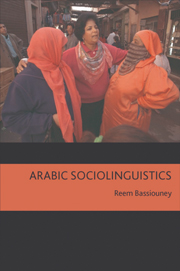Book contents
- Frontmatter
- Contents
- Acknowledgements
- List of charts, maps and tables
- List of abbreviations
- Conventions used in this book
- Introduction
- 1 Diglossia and dialect groups in the Arab world
- 2 Code-switching
- 3 Language variation and change
- 4 Arabic and gender
- 5 Language policy and politics
- General conclusion
- Bibliography
- Index
3 - Language variation and change
Published online by Cambridge University Press: 05 August 2013
- Frontmatter
- Contents
- Acknowledgements
- List of charts, maps and tables
- List of abbreviations
- Conventions used in this book
- Introduction
- 1 Diglossia and dialect groups in the Arab world
- 2 Code-switching
- 3 Language variation and change
- 4 Arabic and gender
- 5 Language policy and politics
- General conclusion
- Bibliography
- Index
Summary
There are differences between me and the children in the area. These differences make me feel inferior although some of them are as miserable as I am … They say about me, ‘he is from the countryside. He comes from the place of hunger and murderers … he does not know how to speak Arabic! All villagers are ill this year. They have the hunger disease’.
From the autobiographical novel al-Khubz al-ḥāfī (‘For bread alone’) by the Moroccan writer Muh. ammad Shukrī (2000)The protagonist in the passage above moves from a village to a city. In the village he spoke a dialect of Berber, but now in the city his native language is looked down upon and is associated with poverty and death. If he does not speak Arabic, he will be forever ostracised from this new community. In the novel he does indeed learn to speak Arabic. Because he moves from one place to another and thus breaks his social ties to the village, and because of the negative associations of his native language, he has to give it up in favour of Moroccan Arabic. The change that he undertakes reflects not only on him personally, but also on both his old community and his new one. The association of a particular dialect with economic power and another with poverty is an important factor that will be clear in the study by Holes in Bahrain (1986), discussed in this chapter in section 3.4.2.
- Type
- Chapter
- Information
- Arabic Sociolinguistics , pp. 88 - 127Publisher: Edinburgh University PressPrint publication year: 2009



